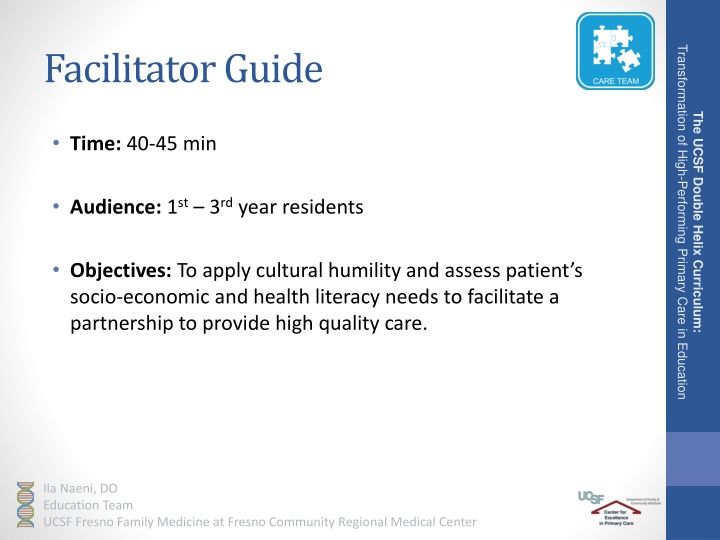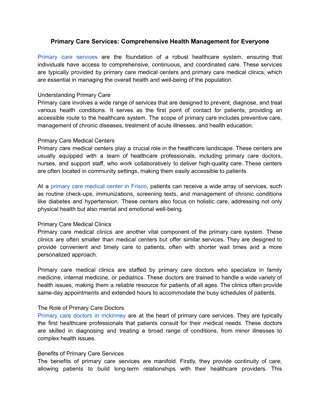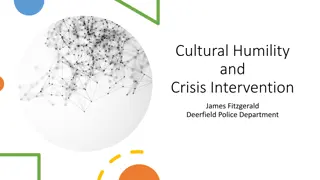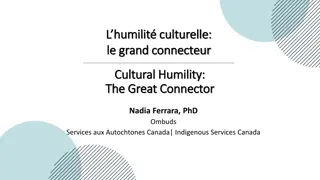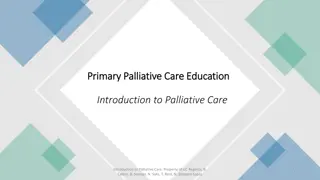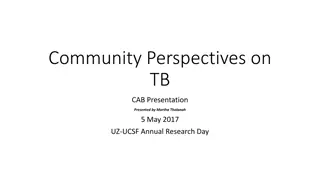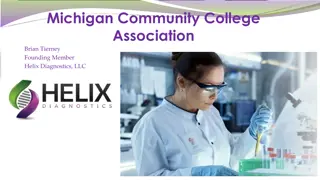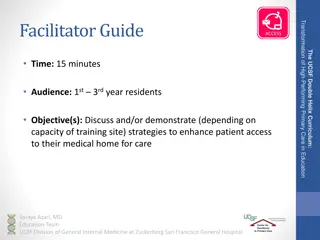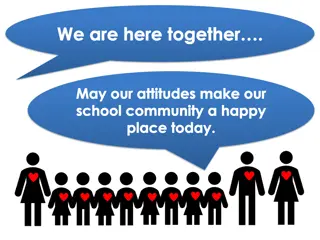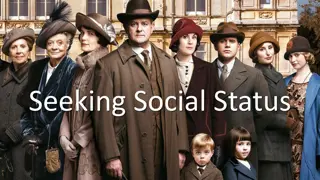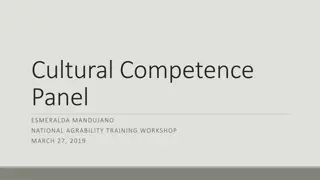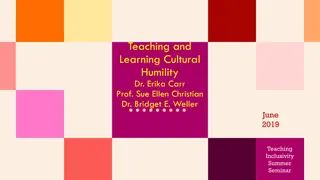UCSF Double Helix Curriculum: Cultural Humility in Primary Care
Transformation of high-performing primary care in education through the UCSF Double Helix Curriculum emphasizing cultural humility, health disparities, and the importance of understanding patient perspectives and needs for delivering quality healthcare. The curriculum aims to bridge the gap between clinicians and patients, address socio-economic and health literacy needs, and promote partnership in care provision.
Download Presentation

Please find below an Image/Link to download the presentation.
The content on the website is provided AS IS for your information and personal use only. It may not be sold, licensed, or shared on other websites without obtaining consent from the author.If you encounter any issues during the download, it is possible that the publisher has removed the file from their server.
You are allowed to download the files provided on this website for personal or commercial use, subject to the condition that they are used lawfully. All files are the property of their respective owners.
The content on the website is provided AS IS for your information and personal use only. It may not be sold, licensed, or shared on other websites without obtaining consent from the author.
E N D
Presentation Transcript
Facilitator Guide Transformation of High-Performing Primary Care in Education The UCSF Double Helix Curriculum: Time: 40-45 min Audience: 1st 3rdyear residents Objectives: To apply cultural humility and assess patient s socio-economic and health literacy needs to facilitate a partnership to provide high quality care. Ila Naeni, DO Education Team UCSF Fresno Family Medicine at Fresno Community Regional Medical Center
Transformation of High-Performing Primary Care in Education The UCSF Double Helix Curriculum: Cultural Humility and Health Care Disparities Adapted from Dr. Ellen Chen s lecture Using and Equity Lens in Primary Care Quality Improvement and UCSF s Cultural Issues in Pediatric Asthma Care. Ila Naeni, DO Education Team UCSF Fresno Family Medicine at Fresno Community Regional Medical Center
Transformation of High-Performing Primary Care in Education Objectives The UCSF Double Helix Curriculum: Recognize differences between the clinician and patient view of health and illness may lead to poor adherence Learn tools to practice cultural curiosity and humility Review health disparities and health care disparities Review the complex causes of health care disparities Describe how QI can be used to identify disparities and help eliminate them Ila Naeni, DO Education Team UCSF Fresno Family Medicine at Fresno Community Regional Medical Center
Transformation of High-Performing Primary Care in Education Why Cultural Humility? The UCSF Double Helix Curriculum: Differences between the clinician and patient view of health and illness may lead to poor adherence Limited information about cultural responses to ill health can contribute to patient-provider miscommunication Through over-confidence in their own cultures, clinicians can lose sight of their patient s perspectives, beliefs, and wisdom Cultural humility reminds providers to be curious about and actively engage their patient s cultural perspectives Culture and language can profoundly affect Latino children s health, but not enough cultural competency training of health care professionals and provision of linguistically appropriate care occur. Cross, et al Cross, T., Bazron, B., Dennis, K., & Isaacs, M. (1989). Towards a culturally competent system of care, volume I. Washington, D.C.: Georgetown University Child Development Center, CASSP Technical Assistance Center. Flores G. et al. The Health of Latino Children: Urgent priorities, unanswered questions, and a research agenda (2002 ) JAMA Ila Naeni, DO Education Team UCSF Fresno Family Medicine at Fresno Community Regional Medical Center
Transformation of High-Performing Primary Care in Education Case: Cultural Disconnect The UCSF Double Helix Curriculum: Ila Naeni, DO Education Team UCSF Fresno Family Medicine at Fresno Community Regional Medical Center
Transformation of High-Performing Primary Care in Education Case: Cultural Disconnect The UCSF Double Helix Curriculum: Ila Naeni, DO Education Team UCSF Fresno Family Medicine at Fresno Community Regional Medical Center
Transformation of High-Performing Primary Care in Education Why Cultural Humility? The UCSF Double Helix Curriculum: Nearly half of the children in California are Hispanic and/or have a foreign-born parent. Currently one of three of families speak a language other than English It is projected that by 2020, 76% of our children will be from ethnic or racial minority groups One out of every 8 children in the United States lives in California Cross, T., Bazron, B., Dennis, K., & Isaacs, M. (1989). Towards a culturally competent system of care, volume I. Washington, D.C.: Georgetown University Child Development Center, CASSP Technical Assistance Center. Ila Naeni, DO Education Team UCSF Fresno Family Medicine at Fresno Community Regional Medical Center
Transformation of High-Performing Primary Care in Education The UCSF Double Helix Curriculum: Practicing Cultural Humility and Curiosity: Tools and Strategies for Everyday Practice Ila Naeni, DO Education Team UCSF Fresno Family Medicine at Fresno Community Regional Medical Center
Practicing Cultural Humility: Addressing Differences in Perceptions about Illness Transformation of High-Performing Primary Care in Education The UCSF Double Helix Curriculum: Patients have explanatory models of illness that are influenced by culture Can be challenging when the provider is not familiar with patient s background Differing perceptions about illness affect treatment by Preventing the sharing of information during visit (e.g., history of symptoms, etc.) Posing challenges to the development of a feasible plan Motivating the patient around the importance of adherence to a plan Carillo JE, et al. Cross-cultural primary care: a patient-based approach (1999). Ann Intern Med. 130: 829-834 Ila Naeni, DO Education Team UCSF Fresno Family Medicine at Fresno Community Regional Medical Center
Practicing Cultural Humility: Addressing Challenges Tool: Awareness-Assessment-Negotiation Technique Transformation of High-Performing Primary Care in Education The UCSF Double Helix Curriculum: Become Aware of the commonly held ethnomedical beliefs of the groups in your community Assess the likelihood that a particular patient may act on these beliefs during a particular illness episode Negotiate between the biomedical and ethnomedical belief systems Ila Naeni, DO Education Team UCSF Fresno Family Medicine at Fresno Community Regional Medical Center
Transformation of High-Performing Primary Care in Education Practicing Cultural Curiosity: Tool Asthma History: example questions What do you think is wrong? Why do you think you have this illness? What do you think caused it? Why do you think it started when it did? What do you think happens inside your body when you have an asthma attack? What are the symptoms that make you know that you re going to have an asthma problem? What are you most worried about with asthma? What problems does it cause you? How long do you expect it to last? How do you treat it? What will happen if it is not treated? What do you expect from the therapies? Practicing Cultural Competency: Tools Modified from Kleinman A. Patient and healers in the The UCSF Double Helix Curriculum: context of culture. 1980. U of C Press. Berkeley. Ila Naeni, DO Education Team UCSF Fresno Family Medicine at Fresno Community Regional Medical Center
Practicing Cultural Humility: Tool Alternative Therapy History Transformation of High-Performing Primary Care in Education The UCSF Double Helix Curriculum: Preface conversation with a normalizing statement e.g. It is common for families to treat asthma with effective remedies not prescribed by a physician Then engage the patient with nonjudgmental questions Have you heard of any of these treatments for asthma? What are they? Do you think they would work? Have you tried them? Did they work? Are you using them now? Are they helping your asthma? Modified from Pachter LM, et al. Variation in asthma beliefs and practices among mainland Puerto Ricans, Mexican-Americans, Mexicans and Guatemalans. J Asthma. 2002; 39:119-134. Ila Naeni, DO Education Team UCSF Fresno Family Medicine at Fresno Community Regional Medical Center
Practicing Cultural Humility: Tool Non-Verbal Communication Skills Transformation of High-Performing Primary Care in Education The UCSF Double Helix Curriculum: Learn about your patient s cultural norms regarding personal distance, gestures, eye contact and posturing Watch your patients for clues about cultural norms. If you are not sure about their cultural norms, ask them. Example questions include: How do you and your family prefer that we discuss difficult news, if it ever comes up? Some patients prefer to work with the physician to make a plan together. Others prefer that I just tell them what I think the best plan is. What is your preference? When using an interpreter, speak directly to the patient and don t interpret lack of eye contact as a lack of interest Be aware that use of an interpreter can change the dynamics of the provider patient relationship and affect the sharing of sensitive personal info Ila Naeni, DO Education Team UCSF Fresno Family Medicine at Fresno Community Regional Medical Center
Case: Cultural Humility in Action Transformation of High-Performing Primary Care in Education The UCSF Double Helix Curriculum: Ila Naeni, DO Education Team UCSF Fresno Family Medicine at Fresno Community Regional Medical Center
Case: Cultural Humility in Action Transformation of High-Performing Primary Care in Education The UCSF Double Helix Curriculum: Ila Naeni, DO Education Team UCSF Fresno Family Medicine at Fresno Community Regional Medical Center
Transformation of High-Performing Primary Care in Education The UCSF Double Helix Curriculum: Health Care Disparities Ila Naeni, DO Education Team UCSF Fresno Family Medicine at Fresno Community Regional Medical Center
Definitions: Health Disparities vs Health Care Disparities Health Disparities Systemic differences in health between groups that differ in social privilege Contributing factors include physical and social environment, lifestyle, stress, genetics and healthcare. Transformation of High-Performing Primary Care in Education The UCSF Double Helix Curriculum: Health Care Disparities Systemic differences in healthcare between groups that differ in social privilege. HCD account for a small proportion of Health Disparities. Ila Naeni, DO Education Team UCSF Fresno Family Medicine at Fresno Community Regional Medical Center
Health Disparities Example: Cause of death in SF: Ischemic Heart Disease 2009-2012 Transformation of High-Performing Primary Care in Education Health Matters in SF The UCSF Double Helix Curriculum: Age-adjusted Mortality Rates from IHD By Race/Ethnicity and Sex, SF African Am White Latino Asian M 150.2 M 107.1 M 88.7 M 67.8 F 113.8 F 69.4 F 44.4 F 40.4 Per 100,000 population Based on ICD9 codes for leading cause of death SF Department of Public Health Ila Naeni, DO Education Team UCSF Fresno Family Medicine at Fresno Community Regional Medical Center
Health Disparities Example: Cause of death in SF: Cerebrovascular disease 2009-2012 Transformation of High-Performing Primary Care in Education Health Matters in SF The UCSF Double Helix Curriculum: Age-adjusted Mortality Rates from Stroke By Race/Ethnicity and Sex, SF African Am Asian Latino White M 59.9 M 41.1 M 31.3 M 25.8 F 53.7 F 33.6 F 28.1 F 28.0 Per 100,000 population Based on ICD9 codes for leading cause of death SF Department of Public Health Ila Naeni, DO Education Team UCSF Fresno Family Medicine at Fresno Community Regional Medical Center
Brainstorm! What are potential causes of this disparity in stroke mortality rates? Safe exercise options Healthy food choices Target tobacco ads vs. target public health education Lifestyle choices Stress Employment Housing Genetics SES/ literacy Transformation of High-Performing Primary Care in Education The UCSF Double Helix Curriculum: Primary care access and use Primary care quality for hyperlipidemia, HTN, DM, tobacco counseling Medication education/access Language access Health literacy Diagnosis and treatment of TIA/ CVA Access to acute interventions Referral to carotid endarterectomy Ila Naeni, DO Education Team UCSF Fresno Family Medicine at Fresno Community Regional Medical Center
Transformation of High-Performing Primary Care in Education HCD: What is known so far? The UCSF Double Helix Curriculum: There are differences in the process of health care for racial and ethnic minorities. Multiple studies have documented differences in care: A study of 17,400 Medicare patients presenting with TIA showed African Americans were 83% as likely as whites to receive noninvasive cerebrovasular imaging. Those who did were 54% as likely to receive noninvasive cerebral angiography. Among this last group, the odds ratio of African Americans receiving carotid endarterectomy was 0.27. The study adjusted for comorbid illness, ability to pay, and other demographic variables. Mitchell 2000 Ila Naeni, DO Education Team UCSF Fresno Family Medicine at Fresno Community Regional Medical Center
Unequal Treatment Confronting Racial and Ethnic Disparities in Healthcare Transformation of High-Performing Primary Care in Education The UCSF Double Helix Curriculum: In 2002, the Institute of Medicine released this report, reviewing the evidence that racial and ethnic minorities receive lower quality of care, even when socioeconomic and access-related factors are controlled. Race and ethnicity are predictors of the quality of healthcare received. http://www.iom.edu/Reports/2002/Unequal-Treatment- Confronting-Racial-and-Ethnic-Disparities-in-Health-Care.aspx Institute of Medicine 2002 Ila Naeni, DO Education Team UCSF Fresno Family Medicine at Fresno Community Regional Medical Center
Transformation of High-Performing Primary Care in Education Health Care Disparities Model The UCSF Double Helix Curriculum: Access to Care Clinical Appropriateness and Need Dissimilarity Non-Minority Patient Preferences Difference Minority Operation of healthcare systems and legal and regulatory climate Disparity Quality of Care Provider Bias, Decision Making and Communication Source: Gomes, C. and McGuire T.G. 2001. Identifying the sources of racial and ethnic disparities in health care use. Unpublished manuscript cited in: IOM,. 2002. Unequal Treatment: Confronting Racial and Ethnic Disparities in Health Care. Smedley, B., A. Stith and A. Nelson, eds. Washington DC: National Academy Press Ila Naeni, DO Education Team UCSF Fresno Family Medicine at Fresno Community Regional Medical Center
Healthcare systems and legal regulatory climate Macrosystems No universal health insurance Low Medicaid reimbursement Pay for performance induces providers to choose healthier patients, avoid complex social situations Microsystems within Delivery systems Appointment systems may be easier to navigate for some, assume free time during the day Team delivery of care can decrease barriers Interpreter services decrease barriers Health coaches decrease barriers Transformation of High-Performing Primary Care in Education The UCSF Double Helix Curriculum: Ila Naeni, DO Education Team UCSF Fresno Family Medicine at Fresno Community Regional Medical Center
Essential Characteristics of Quality Health Care Transformation of High-Performing Primary Care in Education The UCSF Double Helix Curriculum: Effective Patient-centered Timely Safe Equitable Efficient Institute of Medicine 2001 Ila Naeni, DO Education Team UCSF Fresno Family Medicine at Fresno Community Regional Medical Center
Framing HCD as a Quality of care problem Transformation of High-Performing Primary Care in Education The UCSF Double Helix Curriculum: Health and Human Services Secretary required to submit annual report to Congress: National trends in health care quality (National Healthcare Quality Report, or NHQR) Prevailing disparities in health care delivery as it relates to racial factors and socioeconomic factors in priority populations (NHDR Mandated by Congress in Healthcare Research and Quality Act (PL. 106-129) Agency for Healthcare Research and Quality. http://www.ahrq.gov/research/findings/nhqrdr/nhdr11/ index.html# Ila Naeni, DO Education Team UCSF Fresno Family Medicine at Fresno Community Regional Medical Center
ACCESS: After years without improvement, the rate of uninsurance among adults ages 18- 64 decreased substantially during the first half of 2014 Transformation of High-Performing Primary Care in Education The UCSF Double Helix Curriculum: Adults ages 18-64 who were uninsured at the time of interview, 2000-2014 1st Affordable Care Enrollment Begins Marketplace 50 40 30 Percent 20 10 0 National Center for Health Statistics, National Health Interview Survey, 2000-June 2014. Ila Naeni, DO Education Team UCSF Fresno Family Medicine at Fresno Community Regional Medical Center
Equity as a Quality issue: Interventions Transformation of High-Performing Primary Care in Education The UCSF Double Helix Curriculum: Do QI efforts reduce or increase HCD? Broad range of interventions Mixed results Expert consensus that general QI may help but probably not sufficient to reduce HCD Instead, tailored interventions to particular racial/ethnic groups Ila Naeni, DO Education Team UCSF Fresno Family Medicine at Fresno Community Regional Medical Center
HCD as a Quality of care problem: Interventions Transformation of High-Performing Primary Care in Education The UCSF Double Helix Curriculum: Target all patient but use culturally appropriate approaches RCT for depression [Miranda 2003] Target specific groups who have been receiving lower-quality care Aetna s diabetes management pilot program for African Ams and Latinos Ila Naeni, DO Education Team UCSF Fresno Family Medicine at Fresno Community Regional Medical Center
Transformation of High-Performing Primary Care in Education Best Practices The UCSF Double Helix Curriculum: Finding Answers: Disparities Research for Change http://www.solvingdisparities.org/tools/roadmap Multifaceted approaches Focus on cultural relevancy Nursing staff led programs Interactive education Family and community programs Ila Naeni, DO Education Team UCSF Fresno Family Medicine at Fresno Community Regional Medical Center
Supporting Accreditation Organizations and Policy Transformation of High-Performing Primary Care in Education The UCSF Double Helix Curriculum: Joint Commission Centers for Medicare and Medicaid NCQA Affordable Care Act 2010 American Recovery and Reinvestment Act 2009 Medicare Improvements for Patients and Providers Act 2008 Ila Naeni, DO Education Team UCSF Fresno Family Medicine at Fresno Community Regional Medical Center
National Committee for Quality Assurance standards Transformation of High-Performing Primary Care in Education The UCSF Double Helix Curriculum: Data Collection Methods and Policies Access, Availability and Evaluation of Language Services Network Diversity and Cultural Competence Commitment to Accountability and Quality Improvement Ila Naeni, DO Education Team UCSF Fresno Family Medicine at Fresno Community Regional Medical Center
Transformation of High-Performing Primary Care in Education The FOCUS-PDCA Cycle The UCSF Double Helix Curriculum: Find a process improvement opportunity Organize a team of individuals who understand the process Clarify current knowledge about the problem Uncover/understand the causes of variation Select a process improvement/Start the PDCA cycle Ila Naeni, DO Education Team UCSF Fresno Family Medicine at Fresno Community Regional Medical Center
Transformation of High-Performing Primary Care in Education FOCUS-PDCA (cont.) The UCSF Double Helix Curriculum: Plan the process improvement Do the process improvement, data collection, and data analysis Check/study the results Act by abandoning, adjusting or adapting the change; hold on to gains Ila Naeni, DO Education Team UCSF Fresno Family Medicine at Fresno Community Regional Medical Center
Transformation of High-Performing Primary Care in Education Hypertension Control The UCSF Double Helix Curriculum: About 1/3 of US adults, 67 million, have high blood pressure Only 47% of these adults have their BP under control 89% of this population reported a usual source of care Vital Signs: Awareness and Treatment of Uncontrolled Hypertension Among Adults United States, 2003 2010.CDC. Ila Naeni, DO Education Team UCSF Fresno Family Medicine at Fresno Community Regional Medical Center
Primary Care Providers Perceptions of Racial/Ethnic and Socioeconomic Disparities in Hypertension Control Conclusion: Most providers acknowledged that racial/ethnic and socioeconomic disparities in hypertension control exist in the US health system, but only a minority reported disparities in care among patients they personally treat. Our study highlights the need for testing an intervention aimed at increasing provider awareness of disparities within the local health setting to improve hypertension control for minority patients. Transformation of High-Performing Primary Care in Education The UCSF Double Helix Curriculum: Ila Naeni, DO Education Team UCSF Fresno Family Medicine at Fresno Community Regional Medical Center
Transformation of High-Performing Primary Care in Education Summary The UCSF Double Helix Curriculum: Address differences in perception about illness Practice cultural competency and cultural humility HCD are issues of Quality of care. Focus on systems of care as well as physician behaviors is necessary. We can use QI to address HCD in the microsystems in which we work. Ila Naeni, DO Education Team UCSF Fresno Family Medicine at Fresno Community Regional Medical Center
Transformation of High-Performing Primary Care in Education The UCSF Double Helix Curriculum: Evaluation Ila Naeni, DO Education Team UCSF Fresno Family Medicine at Fresno Community Regional Medical Center
